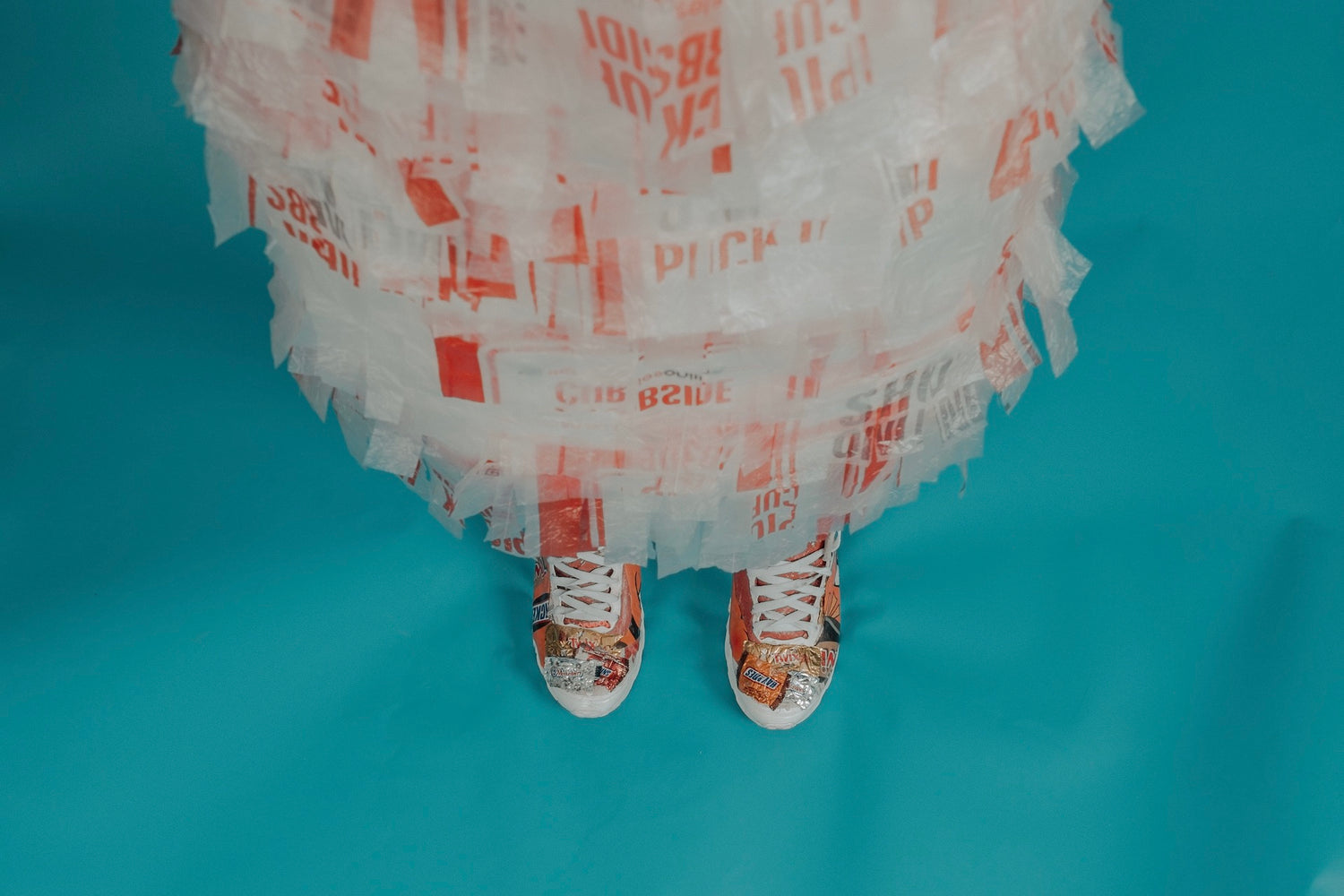To the tune of Tomorrow. All together now!
Ahem. Oh, so much talk about recycling and recycled materials. Sustainable fashion activists have been imploring us to use what’s already on the planet for ages, and the fashion industry has consistently been called out for its overuse of virgin materials. Now that even the biggest fashion brands have hopped on the recycling bandwagon, it’s almost normal to see recycled materials making up some of their clothing lines.
Since more people are getting hyped up about recycling in fashion, let’s get more into it. This article will cover everything you need to know about recycling in fashion. And if we’ve skipped something, drop a comment below and we’ll make sure to cover it.
Materials used for recycled clothing
You’d think that the first material used for recycled clothing would be… clothing. But nope. The stats show that only 1% of clothes get recycled into new ones. Here’s a list of the most commonly used materials to create recycled clothing:
1. Plastic bottles
The most common source is recycled polyester (rPET). And what is recycled polyester made of? Plastic bottles!
Textile Exchange estimates that 99% of all recycled polyester is made from PET plastic bottles. The remaining 1% can be made from post-consumer plastics like ocean waste, discarded polyester textiles, or pre-consumer processing waste like fabric scraps.
Textile Exchange also states that out of the 8.5% recycled fibre market share of total global fibre production, 7.9% of it is from recycled polyester from plastic bottles. Another study conducted by StyleSage from 2018 to 2021 on recycled clothing in the U.S. showed that the most used recycled fibre was recycled polyester (56%).
Recycled polyester constitutes 15% of total polyester fibre production.
2. Fishing nets
According to StyleSage’s study, recycled nylon accounts for almost 10% of all recycled clothing in the U.S., much of which is produced using old fishing nets found in the ocean. Nylon is a type of polyamide, and it can be made from pre-consumer waste like processing scraps, fabric cut-offs, or hard polyamide waste, or from post-consumer waste like discarded industrial fishing nets. Considering that ghost fishing gear was called out by the WWF as the deadliest form of marine plastic, and constitutes at least 10% of total ocean pollution, it’s a promising alternative to virgin nylon. Especially when you consider the most popular brand making this material, ECONYL®, creates nylon that’s infinitely recyclable without any loss in quality.
Recycled polyamide constitutes 2% of total polyamide fibre production.
3. Carpets
Similar to fishing nets, another material that is used to make recycled nylon, or recycled polyamide, is old carpets. Yep, old carpet fluff might be in your recycled activewear or swimwear. But don’t worry - it goes through a cleaning, regeneration, and purification process that returns the carpet to its original virgin nylon state.
4. Wool
Recycled wool is one material that’s used for textile-to-textile recycling. It has a long tradition, and the Italian district of Prato is a major producer of recycled wool. Considering that most wool (94%) used for clothing is made from conventionally sourced virgin wool, which is resource-intensive and unethical, more brands are looking to recycled wool as it’s readily available, easily recyclable, and can produce high-quality yarns. Recycled wool is sustainable as it avoids the direct harm of animals and uses what’s already on the planet. When buying recycled wool, look for the certifications Recycled Claim Standard (RCS), Global Recycled Standard (GRS), or Cardato Recycled for recycled wool from Prato in Italy.
 Wool comes primarily from sheep.
Wool comes primarily from sheep.
Recycled wool constitutes 6% of total wool fibre production.
5. Cotton
Recycled organic cotton is one of the best and most sustainable materials - with an emphasis on organic, as conventional cotton is exceptionally resource-intensive and harmful. Organic cotton requires 91% less water, doesn’t use pesticides, promotes soil health, and uses natural dyes.
The majority of recycled cotton is sourced from pre-consumer waste, i.e. fabric scraps from production. Post-consumer waste is more difficult to sort through due to colour dyes, fabric blends, and a more labour-intensive process. Recycled cotton is often blended with virgin cotton to maintain high-quality standards. Otherwise, it tends to lose its strength and durability, as cotton cannot be recycled indefinitely.
 Cotton
Cotton
Recycled cotton constitutes 1% of total cotton fibre production.
6. Silk
Recycled silk is made from silk waste, such as old garments, offcuts, and discarded silk cocoons, but it seems to most often come from industrial silk waste - basically, production scraps. Newly produced silk is often criticised for concerns about ethical practices and sustainability, so recycled silk is a much better alternative.
7. Wood pulp
You might know wood pulp as viscose, lyocell, or modal, which are all man made cellulosics that come from the dissolved wood pulp or “cellulose” of trees. They’re made from the same fibres but go through different processes. You might even know this material under TENCEL™, which is a popular brand name for lyocell and modal fibres.
All wood pulp-based fibres are biodegradable, and they’re increasingly being used by brands that want to incorporate more sustainable materials into their product range. However, deforestation and biodiversity loss are challenges associated with this material. Since only a tiny 0.5% of total wood pulp fibre production is being recycled, there’s a lot of room for improvement. R&D is ongoing, and recycled volumes of wood pulp fibres are expected to increase significantly in the coming years.
 Wood chips turn into wood pulp then fibre
Wood chips turn into wood pulp then fibre
8. Tires
This one’s less common but worthy of mentioning. Yep, clothing can be made from old tires! Between 1 and 1.8 billion tires are disposed of globally each year, representing 2-3% of all waste material collected. Until recently, tires could only be ‘downcycled’ - meaning, recycled into materials that are of lower quality and functionality. But now they can be made into fabrics and then into backpacks, pants, and jackets.
Recycled synthetic fibres vs. recycled plant fibres
Synthetic fibres have dominated the textile industry since the 1990s after overtaking cotton. And this is no different when it comes to recycled clothing. However, recycled synthetics are made from plastic so they release microplastics into the ocean with every wash.
Another thing to consider is that there’s still no reliable recycling system in place for clothing that uses recycled polyester from PET bottles. So while recycled polyester reduces waste, it’s not a circular solution. Paradoxically, the lifespan of PET bottles becomes shorter upon entering the fashion industry, as they could otherwise be recycled more times in a closed-loop economy with the drinks industry.
On the other hand, recycled plant-based fibres like organic cotton, viscose, lyocell, and modal are more gentle on the planet. Recycled animal-based fibres also fall in this same boat, considering that they don’t have the same ethical concerns regarding animal cruelty as virgin animal-based fibres do.
The problem with textile-to-textile recycling
By now, maybe you’re wondering why more clothes aren’t being used for recycling. Plastic bottles, fishing nets, and carpets are cool and all… but what about the 92 million tonnes of textile waste that’s produced each year? Here are a few reasons why textile-to-textile recycling is still an issue:
1. Fabric blends
Textile recycling plants have a hard time breaking down clothing that is made with fabric blends, such as a shirt made from cotton mixed with polyester. Blending synthetic and natural fibres isn’t a sustainable option from a circular design perspective as it means fewer chances of the item being recycled. Not to mention, the natural fibre’s chance of biodegrading will diminish after being blended with plastic.
2. Technologies are underdeveloped
McKinsey states that once technologies are mature, 70% of textile waste in Europe could be fibre-to-fibre recycled. But for now, advanced, accurate, and automated fibre sorting and preprocessing are not yet developed. A lot of work needs to be put into sorting and processing. For example, zippers and buttons need to be removed from jeans.
3. The status quo
It’s becoming so common to create recycled clothing from plastic bottles, that it’s arguably creating another barrier to textile-to-textile recycling. Plastic is the accessible solution to create recycled clothes - especially for fast fashion brands eager to tick the sustainability box.
Yet, textile-to-textile recycling is still very much possible and more fashion brands should be opting for it. A dependence on recycling plastic shouldn’t diminish the rest of the industry - and its financial sustainability.
Brands and initiatives that promote textile-to-textile recycling:
• POMP
We’ll take this moment to give ourselves a shoutout. Here at POMP, we create clothing that’s made from 100% organic cotton, as a single-source material which is the easiest to recycle. That said, we create recycled clothing made from post-consumer cotton, i.e. from the clothes that you send back to us! As you’ve read by now, recycled cotton made from post-consumer and organic cotton is the most sustainable solution and also not that common. Our focus is on high-quality organic basics that last.
 High-quality, organic cotton hoodie
High-quality, organic cotton hoodie

• Circ
Circ is a material innovation company that creates two different types of fibres: Circ® Lyocell which consists of 50% regenerated lyocell from textile waste and 50% FSC-certified virgin cellulosic pulp, and Circ® Polyester which is made from recycled poly-cotton waste using pioneering technology. The latter addresses the huge problem of recycling blended textiles which is faced by the fashion industry.
• CIRCULOSE
CIRCULOSE is a new material, designed by Renewcell, made from 100% textile waste. It’s a ‘dissolving pulp’ that can be used to make viscose, lyocell, modal, acetate, and other types of man-made cellulosic fibres. These fibres are then spun into yarns to be used for clothing. The only difference with CIRCULOSE, is that it’s completely made from textile waste, instead of virgin cotton, oil, or wood.
 Circulose’s cellulose
Circulose’s cellulose
Guide on how to recycle your clothing
If you’re anything like us, then you can relate to feeling that urge to help the recycling movement and advocate for change! Here are a few ways that you can do this:
• Support brands that recycle their clothing
Many brands have take-back programs, designed for you to return your used clothing to them for recycling. We’ve written an article on some of the top recycled clothing brands and named a few that give you this opportunity.
• Start by purchasing your clothing mindfully
One way to help the recycling movement propel within the fashion industry is by buying mindfully. Limit your recycled polyester clothing purchases to the garments that need to be washed the least and last the longest. Think jackets, jeans, hats, and sneakers. Also, try to buy single-fibre clothing, like 100% organic cotton. These are easier to recycle.
• Check for curbside textile recycling bins
Some municipalities/ local authorities, shopping centres and even brand outlets have textile recycling bins, so just do a quick search. It might be much easier than you anticipate!
• And lastly, send your old POMP pieces back to us
If you feel you’ve got enough wear out of your POMP item, don’t forget that you can always send it back to us! Just follow the instructions on the wash care label and you’ll get store credit in exchange for your good deed. And yep, your old POMP garment will be reprocessed and made into new products.


 Crushed PET bottles
Crushed PET bottles Ghost fishing nets
Ghost fishing nets Carpets
Carpets Silk
Silk Tires
Tires